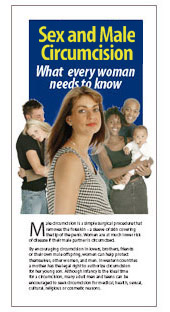Circumcision -
Who In the World Gets Circumcised?
Circumcision is one of the most common medical procedures in the world, with 25 circumcisions performed every minute [Hammond, 1999]. It is also one of the oldest [Dunsmuir & Gordon, 1999; Lerman & Liao, 2001], and one of the simplest.
In the USA, circumcision is the most common operation performed in males [Niku et al., 1995]. A large CDC study found rate is 91% in whites, 76% in blacks and 44% in Hispanic men [Introcaso et al 2013]. Circumcision is virtually routine following birth and is performed in the neonatal nursery mostly because of the wishes of the parents, unrelated to religion. In 2010 a report found 86% of US parents were in favor of neonatal circumcision [Wang et al., 2010]. The USA has, of course, the greatest medical knowledge and medical expertise in the world. In this country, 65-90% of males are circumcised (over 1.2 million newborns per year [Stang & Snellman, 1998; National, 2003]). Those who are not circumcised are mainly from cultures in which it is unfamiliar (e.g., Hispanic, as well as many European and Asian).
Globally approx. 38% of men are circumcised [Morris et al. 2016]. This figure is based on the most detailed analysis to date. It is higher than an outdated estimate of 30% by the World Health Organization (WHO) in 2007 [World, 2008b]. Of circumcised men, 68% in the WHO study were Muslim and 1% Jewish [Weiss et al., 2008a; World, 2008b]. In the more recent study it was estimated that, globally, 62.1% of men had been circumcised for religious reasons [Morris et al. 2016]. Such a high rate for elective surgery involving the genitalia suggests important net benefits. Moreover, in most western countries circumcision, where practiced, tends to be a family tradition that has nothing to do with religion.
With the rise in information from medical research in recent years, informed parents are learning more and more of the lifelong benefits that circumcision can convey to the health and well-being of their children, and are insisting on this simple procedure. In majority populations of the Middle East and in peoples derived from there, such as Jews and Muslims, circumcision is a mandatory part of their religion or culture.
Each year 100,000 Jewish and 10 million Muslim circumcisions are performed, while in Africa the number is 9 million. Circumcision predates Islam and Judaism. It was depicted in ancient Egyptian writings and pictures 5000 years ago.
Circumcision and/or foreskin retraction of the penis are also present in most male figures in art forms from the Upper Paleolithic period in Europe (38,000 to 11,000 years BCE) [Angulo & García-Díez, 2009]. Some depict a circumcised penis and others represent urological disorders in uncircumcised individuals, such as phimosis, paraphimosis, urethral discharge, priapasm or scrotal mass. They are indicative of primitive urological knowledge.
It was practiced by the non-Jewish inhabitants of North Africa and Asia Minor long before the birth Mohammed. In fact, circumcision is not mentioned in the Qu'ran (Koran). It came into Islam not from Judaism, but because it was already the custom of the Arab people, who were the first Muslims.
The Greek mathematician Pythagoras had to be circumcised before he was allowed to study in the library of the University of Alexandria (the world's oldest documented University). This was long before Christ or Mohammed. Since Greeks did not approve of circumcision it shows how great Pythagoras' thirst for knowledge must have been!
On the other side of the world in Australia, aboriginals also practice circumcision, as do Pacific Islanders. So did the Aztecs. Why is this? A common theme in each case is that these diverse races and cultures have traditionally inhabited a hot and sometimes arid sandy environment, where the heat, sweat and, often, sand getting under the foreskin would be expected to cause considerable irritation.
Ritual removal has been the outcome, irrespective of whether this was a "command from God" or just plain common sense, that when embedded in the religion or culture over millennia lost its original health-related significance.
Interestingly, in some places, such as Madagascar, circumcision is 100% regardless of religion, and is dictated by the women, who maintain that circumcised sex is "longer, stronger and cleaner". All of this is good "dinner party" conversation. However, sociology is a muddy area to trek in to, so this review tries to steer clear of issues like this, as well as religion, as far as possible, but not completely!
![]()
NEXT SECTION CLICK HERE:



